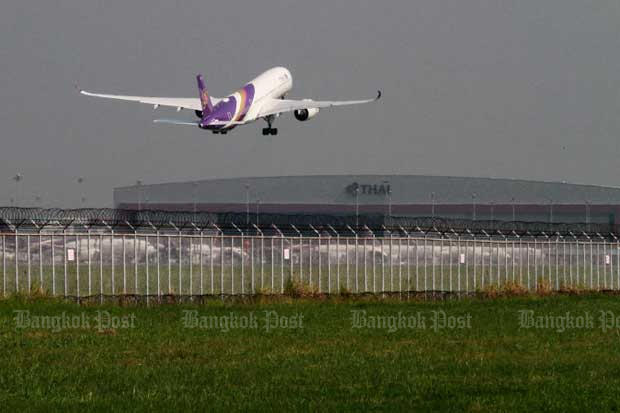
Nok Air is embarking on a business recovery plan, but the struggling budget airline's boss says it's a non-starter to expect the company to find its way out of deep financial woes anytime soon.
"It's unrealistic to expect us to be back in the black this year due to the depth of problems, but maybe we can break if our remedial plan works well and no significant impact from external factors arises," chief executive Patee Sarasin told the Bangkok Post.
He was responding candidly for the first time after last week's declaration of a record loss of 3.28 billion baht for 2016, up from 1.66 billion baht in the previous year.
Nok Air was in the spotlight again because it was the only aviation-related firm listed on the Thai bourse to post losses last year.
Thai Airways International, Bangkok Airways and Asia Aviation (the parent firm of Thai AirAsia) all reported profits.
"Let me put it this way, Nok Air was in a less fortunate situation than others because of unexpected factors that hit us on many fronts, and were well beyond our control," Mr Patee said.
The 55-year-old executive said the recovery plan zeroes in on trimming aircraft capacity, improving aircraft utilisation and tightening cost controls.
The airline has had aircraft overcapacity issues and needs to shed roughly 5% to bring its fleet to network and frequency equilibrium.
Nok Air this year will sublease three or four Boeing 737-800 jets from its fleet, which includes 22 B737-800s, eight Bombardier Q400s turboprops and two ATR 72-500 turboprops.
Last year, the airline added five brand-new aircraft, three B737-800s and two Bombardier Q400s, which contributed to aircraft glut.
As part of its improvements, the airline will work to boost aircraft utilisation to about 10 hours a day from eight at present, according to Mr Patee.
Flying night charter flights to China and India will help Nok Air raise aircraft utilisation, which suffered pilot incidents and consequential flight cancellations in February-March last year.
Aircraft maintenance costs, a key factor that pushed Nok Air's balance sheet into the red last year, will be subject to more cost-control discipline without compromising safety requisites, Mr Patee said.
Almost half of higher operation costs were fuelled by aero-engine maintenance costs, which happened to reach the same service cycles at the same time, he said.
Nok Air said in its financial statement that total operating costs last year soared by 14.1% to 15.74 billion baht, due to maintenance expenses for aero-engines and aircraft, as well as aircraft lease rental, which had edged up with the fleet expansion.
Combined revenue in 2016 fell by 2% year-on-year to 13.11 billion baht, due to a decrease in domestic flights and lower average airfares caused by intense price competition.
Losses from Nok Air's own operations in the year amounted to 2.80 billion baht, higher than projected, while losses from its affiliated medium-to-long haul NokScoot amounted to 473.48 million baht.
Nok Air's cost per available seat kilometre was 2.51 baht, up 12.1% from the previous year.
Revenue per available seat kilometre fell to 2.02 baht from 2.24 baht a year ago.
This year, Nok Air targets to retain similar numbers of passengers as last year, at 8.56 million, which is expected to be appropriate for the airline's reduced aircraft capacity.
At the same time, Nok Air will strive to sustain a cabin load factor above 80%, Mr Patee said.
Nok Air's cabin factor rose to 85.1% in 2016 from 84% in the previous year.
This year, some poor-performing domestic routes will be terminated and the frequency of flights on profitable routes such as those from Bangkok to Udon Thani and Bangkok to Ubon Ratchathani will be increased.
Internationally, Nok plans to start serving Phnom Penh from Bangkok for the first time in October, and debut regular services to several Indian cities.


